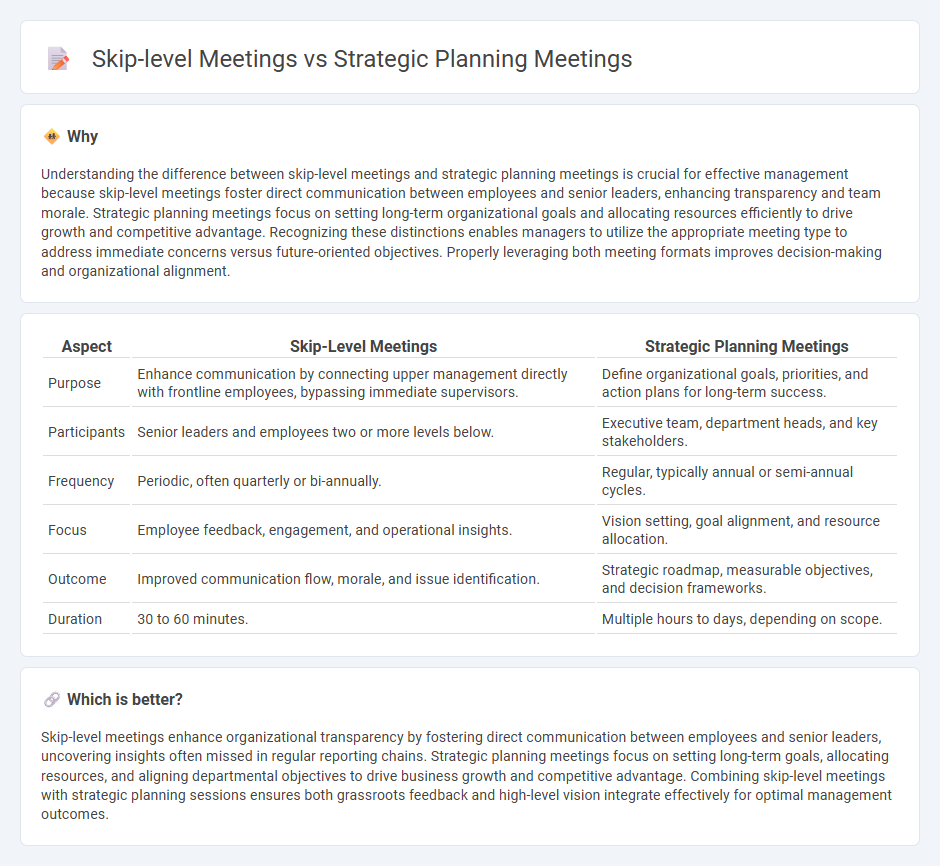
Skip-level meetings focus on direct communication between senior leaders and employees bypassing immediate supervisors, fostering transparency and uncovering frontline insights. Strategic planning meetings involve key decision-makers collaborating to set long-term goals and allocate resources aligned with organizational vision. Explore effective management techniques to maximize the benefits of both meeting types.
Why it is important
Understanding the difference between skip-level meetings and strategic planning meetings is crucial for effective management because skip-level meetings foster direct communication between employees and senior leaders, enhancing transparency and team morale. Strategic planning meetings focus on setting long-term organizational goals and allocating resources efficiently to drive growth and competitive advantage. Recognizing these distinctions enables managers to utilize the appropriate meeting type to address immediate concerns versus future-oriented objectives. Properly leveraging both meeting formats improves decision-making and organizational alignment.
Comparison Table
| Aspect | Skip-Level Meetings | Strategic Planning Meetings |
|---|---|---|
| Purpose | Enhance communication by connecting upper management directly with frontline employees, bypassing immediate supervisors. | Define organizational goals, priorities, and action plans for long-term success. |
| Participants | Senior leaders and employees two or more levels below. | Executive team, department heads, and key stakeholders. |
| Frequency | Periodic, often quarterly or bi-annually. | Regular, typically annual or semi-annual cycles. |
| Focus | Employee feedback, engagement, and operational insights. | Vision setting, goal alignment, and resource allocation. |
| Outcome | Improved communication flow, morale, and issue identification. | Strategic roadmap, measurable objectives, and decision frameworks. |
| Duration | 30 to 60 minutes. | Multiple hours to days, depending on scope. |
Which is better?
Skip-level meetings enhance organizational transparency by fostering direct communication between employees and senior leaders, uncovering insights often missed in regular reporting chains. Strategic planning meetings focus on setting long-term goals, allocating resources, and aligning departmental objectives to drive business growth and competitive advantage. Combining skip-level meetings with strategic planning sessions ensures both grassroots feedback and high-level vision integrate effectively for optimal management outcomes.
Connection
Skip-level meetings provide executives with direct insights from employees, unveiling frontline challenges and opportunities that inform strategic planning. By integrating feedback gathered in skip-level meetings, management can align strategic initiatives with real operational needs, enhancing decision-making effectiveness. This connection ensures strategic plans are grounded in actual organizational dynamics, improving adaptability and execution.
Key Terms
**Strategic Planning Meetings:**
Strategic planning meetings concentrate on defining long-term goals, allocating resources, and aligning organizational objectives to drive sustained growth. These sessions involve key decision-makers who analyze market trends, evaluate competitive landscapes, and set measurable targets for business development. Explore in-depth insights on how strategic planning meetings can transform your company's future direction.
Vision
Strategic planning meetings concentrate on aligning long-term organizational goals with the overarching vision to guide decision-making and resource allocation effectively. Skip-level meetings provide direct access to employee insights, fostering transparency and enhancing the communication flow between leadership and frontline teams to support vision alignment at all company levels. Discover how leveraging both meeting types can drive a cohesive vision and accelerate organizational success.
Objectives
Strategic planning meetings center on defining long-term organizational goals, allocating resources, and aligning team efforts to drive growth and competitive advantage. Skip-level meetings focus on fostering direct communication between executives and frontline employees, uncovering operational challenges, and promoting transparency in workflow processes. Explore the distinct objectives of these meeting formats to enhance your management strategy.
Source and External Links
What Is a Strategy Meeting? Purpose & Best Practices - A strategy meeting is a focused gathering of key stakeholders to discuss, define, and refine an organization's overarching goals, tactics, and implementation plans.
How to hold a strategic planning meeting | MiroBlog - Strategic planning meetings involve structured agendas with time for leadership and department updates, problem analysis, solution ideation, consensus-building, task assignment, and Q&A, supported by visual tools for effective collaboration.
Sample Strategic Planning Agenda - A strategic planning meeting agenda typically covers organizational values, risk assessment, prioritization, goal setting, communication planning, and action planning, often spread over multiple days for comprehensive review.
 dowidth.com
dowidth.com